Chapter 5 - Cell Metabolism: Synthesis & Degradation of Biological Molecules
1/32
There's no tags or description
Looks like no tags are added yet.
Name | Mastery | Learn | Test | Matching | Spaced |
|---|
No study sessions yet.
33 Terms
endergonic
energy requiring
active transport
anabolism
cell movements
exergonic
releases energy
cell respiration
catabolism
ATP hydrolysis
oxidation
the loss of one or more electrons (Hydrogen)
reduction
gain of one or more electrons (hydrogen)
the more reduced a molecule is, the more potential energy
is NAD+ oxidized or reduced?
NAD+ (oxidized form)
coenzyme NAD+ is a key electron carrier
is NADH oxidized or reduced?
NADH (reduced form)
Reduction of NAD+ is highly _______
Oxidation of NADH is highly ________
Reduction of NAD+ is highly endergonic:
NAD+ + H+ + 2e– ⇌ NADH
Oxidation of NADH is highly exergonic:
NADH + ½ O2 ⇌ NAD+ + H2O
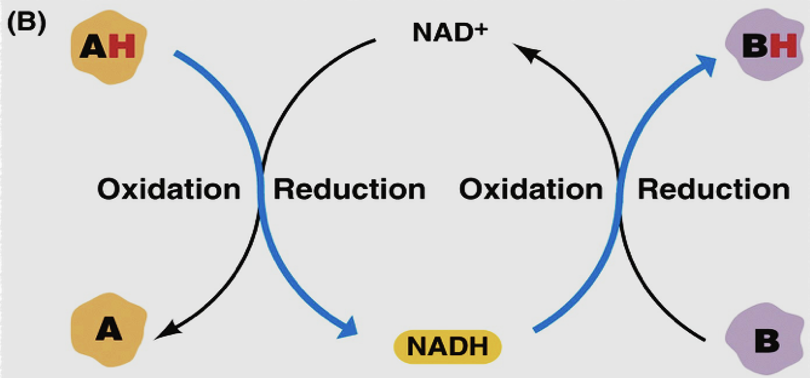
Cellular respiration is a major ______ pathway.
Photosynthesis is a major _____ pathway.
Cellular respiration is a major catabolic pathway.
Glucose is oxidized:
carbohydrate + 6 O2 ⇌ 6 CO2 + 6 H2O + chemical energy
Photosynthesis is a major anabolic pathway.
Light energy is converted to chemical energy:
6 CO2 + 6 H2O + light energy ⇌ 6 O2 + carbohydrate
oxidation occurs in a series of steps in 3 pathways:
glycolysis
pyruvate oxidation
citric acid cycle
glycolysis
10 reactions
takes place in cytosol
end products:
pyruvate (pyruvic acid)
ATP
NADH
pyruvate oxidation
end products:
CO2
acetate (which is then bound to coenzyme A)
NADH
2 types of fermentation and what they do:
lactic acid fermentation: pyruvate is converted to lactic acid
alcoholic fermentation: pyruvate is converted to ethanol
citric acid cycle (krebs cycle)
8 reactions
starts with Acetyl CoA; acetyl group is oxidized to two CO2
oxaloacetate is regenerated in the last step
lots of NADH is made throughout
the organic molecules are oxidized and NAD+ is reduced
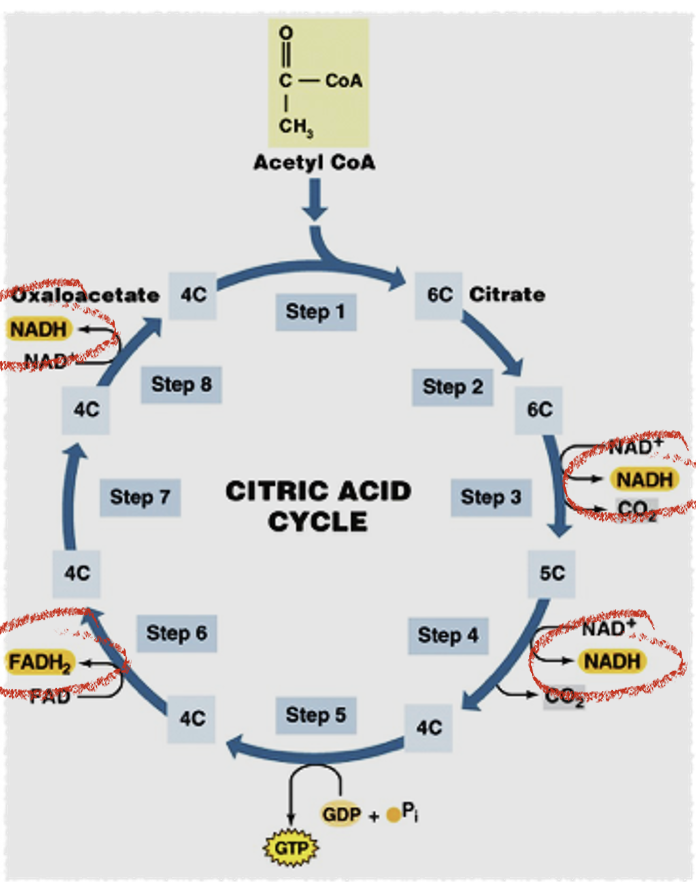
oxidative phosphorylation
transfers energy from NADH to ATP
chemiosmosis
diffusion of protons across a membrane, which drives the synthesis of ATP
converts potential energy of a proton gradient (proton motive force) across a membrane into the chemical energy in ATP
O2 is the _____________ in the respiratory chain
O2 is the final electron (H) acceptor in the respiratory chain
electron transport/ATP synthesis recap
NADH is re-oxidized to NAD+ and O2 is reduced to H2O in a series of steps.
Electron transport chain (aka Respiratory chain) —series of redox carrier proteins embedded in the inner mitochondrial membrane.
Electron transport—electrons from the oxidation of NADH (and FADH2) pass from one carrier to the next in the chain, coupling this electron transfer with the transfer of protons across membrane.
Oxidation reactions are exergonic ; the released energy is used to actively transport H+ ions out of the mitochondrial matrix (in eukaryotes), setting up a proton gradient.
ATP synthase in the membrane uses the H+ gradient to synthesize ATP by chemiosmosis.
2 pathways that photosynthesis involves:
light reactions convert light energy into chemical energy
carbon-fixation reactions use the ATP and NADPH, along with CO2, to produce carbohydrates (glucose)
primary production
synthesis of organic compounds from atmospheric or aqueous CO2
what are the different ways photons can behave?
photons can be absorbed by a molecule, adding energy to the molecule-it moves to an excited state (higher energy)
photons can also be scattered (bouncing off)
photons can also be transmitted (pass through)
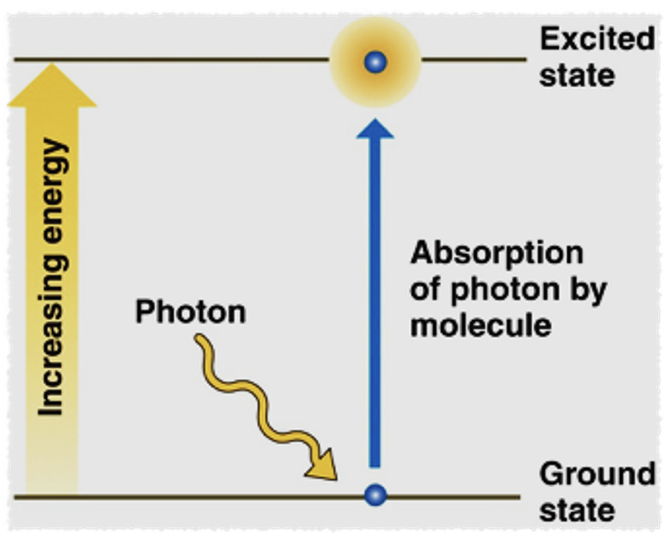
higher energy > ____
_______ > longer wavelength
higher energy > shorter wavelength
lower energy > longer wavelength
accessory pigments
absorb wavelength between red and blue and transfer some of that energy to the chlorophylls
in plants, chlorophyll absorbs light energy
photosystem components (Light-harvesting complexes)
spans the thylakoid membrane in the chloroplast
consists of:
antenna systems
reaction center
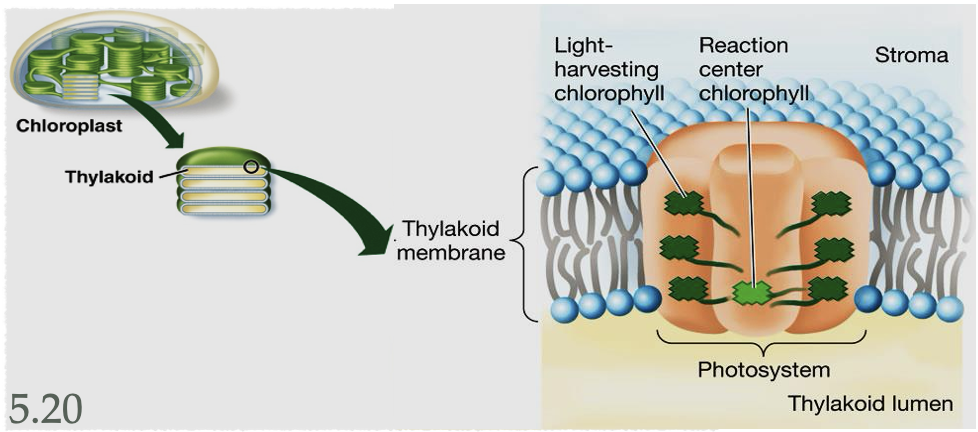
excitement of an electron
When chlorophyll (Chl) absorbs light, it enters an excited state (Chl*), then rapidly returns to ground state, releasing an excited electron.
Chl* gives the excited electron to an acceptor and becomes oxidized to Chl+.
The acceptor molecule is reduced.
Chl* + acceptor ⇌ Chl+ + acceptor–
the reaction center has converted light energy into chemical energy
cyclic electron transport
traps light energy as ATP
ATP is needed for carbon-fixation pathways
cyclic electron transport uses only photosystem 1 and produces ATP
the electron passed from an excited chlorophyll is recycled back to the same chlorophyll
what do plants use all the NADPH for?
One of the main functions of photosynthesis is to supply electrons for carbon fixation
NADPH supplies the electrons (as H atoms) to reduce CO2 to carbohydrates.
This is essentially the reverse of respiration where carbohydrates are oxidized to CO2 and the electrons are captured in NADH.
where does the calvin cycle occur
in the stroma of the chloroplast
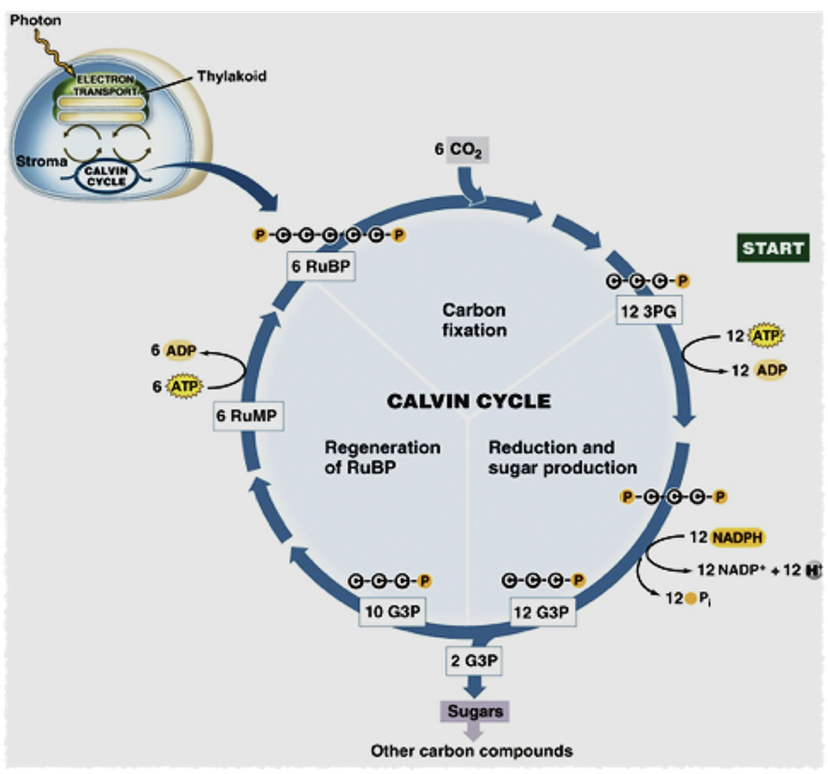
3 steps of calvin cycle/dark reactions:
carbon fixation
reduction and sugar production
regeneration of RuBP
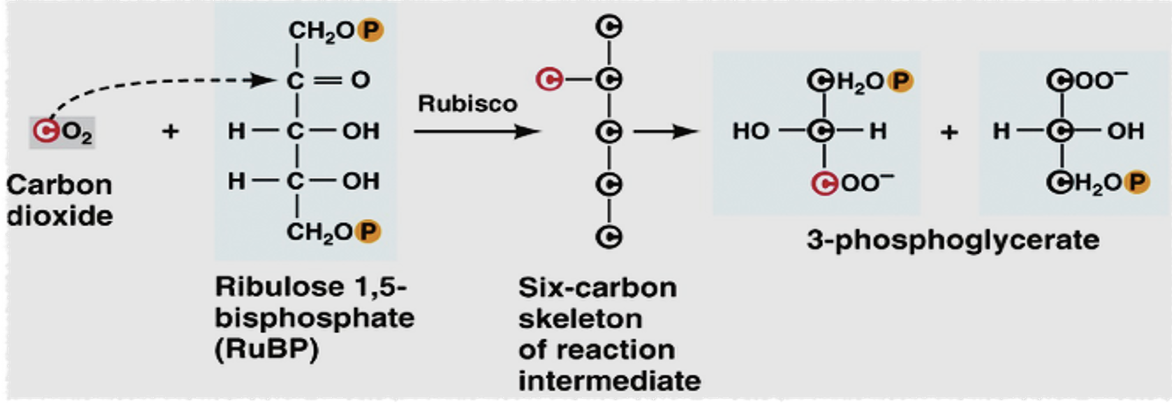
carbon fixation
CO2 is added to 5-C backbone ribulose 1,5-bisphosphate (RuBP).
Ribulose bisphosphate carboxylase/oxygenase (rubisco) catalyzes the reaction.
A 6-C molecule results, which quickly breaks into two 3-carbon molecules: 3-phosphoglycerate (3PG)
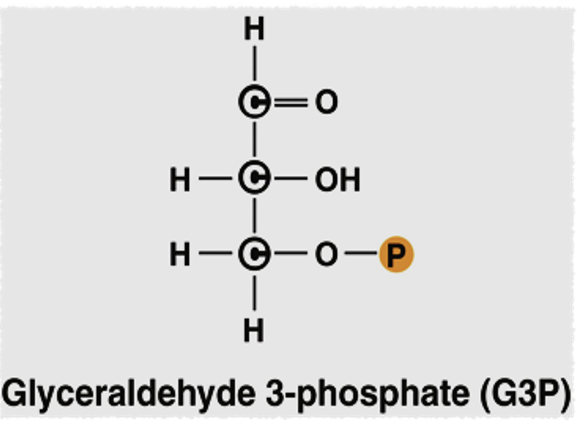
reduction and sugar production
3PG is reduced to form glyceraldehyde 3-phosphate (G3P).
3PG is used to make sugars
When glucose accumulates, it is linked to form starch, a storage carbohydrate
regeneration of RuBP
The CO2 acceptor, RuBP, is regenerated from G3P.
1/6th of the G3P is used to form sugars
The rest is used to regenerate RuBP
light reactions
a) two photosystems
photons, pigments (chl)
cyclic, noncyclic PS
b) electron transport chain
c) light energy à chemical energy
NADPH, ATP
dark reactions
a) C-fixation
rubisco, ribulose-1,6-bisphosphate (RuBP),
and 3-phosphoglycerate (3GP)
b) reduction
glyceraldehyde-3-phosphate (G3P)
c) regeneration of RuBP